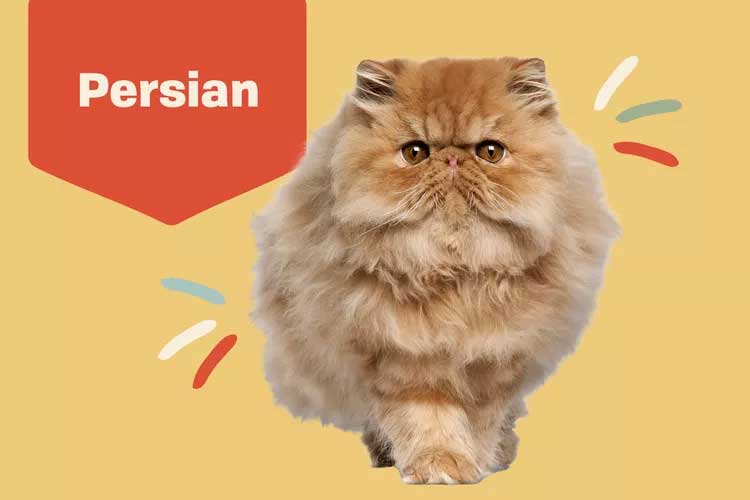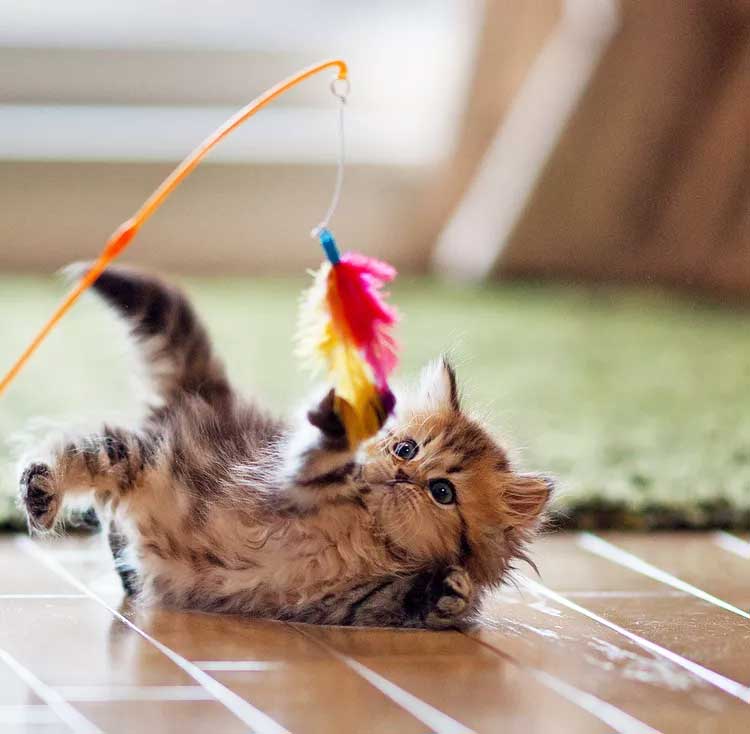Sweet tempered and loving, Persian cats are famous for their long, flowing coats and round, pansy-like faces. Find out everything you need to know about the Persian cat breed.

Persian Overview
| OFFICIAL NAME | Persian |
| COMMON NAME | Persian |
| PET HEIGHT | 10 to 15 inches |
| PET WEIGHT | 7 to 13 pounds |
| LIFESPAN | 10 to 15 years |
| GOOD WITH | cats, children, dogs, families, seniors |
| TEMPERAMENT | affectionate, sociable |
| INTELLIGENCE | medium |
| SHEDDING AMOUNT | frequent |
| PLAYFULNESS | medium |
| ENERGY LEVEL | calm |
| VOCAL LEVEL | quiet |
| COAT LENGTH | long |
| COLORS | black / ebony, blue / gray, chocolate / brown / sable, cinnamon, cream / beige / tan, fawn, lavender / silver, lilac, red / orange, white |
| OTHER TRAITS | friendly toward humans, friendly toward other pets, friendly toward strangers, good lap cat, low prey drive, requires lots of grooming, tolerates being alone, tolerates being picked up |
As one of the most recognized and adored cat breeds on the planet, Persian cats have been happily snuggling up with their owners since the 1600s. With their long, flowing coats; thick bodies; and flat faces, it's hard to resist the charm of a Persian.
Persian cats are a medium-sized breed and take their role as a loving companion seriously-they're always ready to be stroked and fussed over on a moment's notice. This beautiful kitty comes in a wide variety of colors and color combos, and they get along with all family members (including fellow furry ones) when introduced as kittens. If you're willing to put in the work with grooming-and it's a lot of work-you won't find a more loving companion.
Appearance
There's no mistaking a Persian cat when you see one. These iconic felines are well-known for their thick fur coats, large eyes, and stocky bodies. But there's one characteristic that immediately comes to mind when you think about a Persian's appearance: Their cute, smooshy faces.These cats are a medium-sized breed, with female Persians weighing between 7-10 pounds and males at a slightly larger 9-13 pounds. That long, lustrous Persian coat comes in a host of colors, including orange, gray, and cream, and their eyes are typically a brilliant copper, green, hazel, or blue.
Over the years, two forms of Persian cat have emerged-the show and the traditional, also known as the doll-face. Show Persians (also called "Peke-face," because they resemble Pekingese dogs) generally have flatter faces, smaller ears, thicker coats, and larger eyes than the traditional. Doll-face Persian cats have less pronounced features and more closely resemble the first recorded images of the breed. But whether your kitty is a Peke-face or doll-face, both share the same sweet demeanor and require daily brushing to keep their long coats from matting.
Temperament
Persians are as sweet as they are stylish! These quiet, elegant beauties are walking love sponges whose main purpose in life is to adore you and be adored in return."Every cat is an individual, which means that the individual cat might not exhibit the temperament attributed to Persians," says Marilyn Krieger, certified cat behavior consultant in San Francisco. "Generally speaking, Persian cats are known to be low-key, social, and affectionate cats [who] love to be next to their person, petted, and cuddled."
Persians are happy and curious cats, but they won't drive you crazy nosing around your home looking for cups of water to knock over. Plus, Persian cats are solidly built, so they're unlikely to attempt climbing the curtains. You're most likely to find them napping on the comfiest cushion they can find.
They also get along with everyone, including dogs, as long as they are socialized when young. Persians are energetic enough to enjoy cat toys and games, but don't need constant entertainment to keep them happy.
Living Needs
Although they may look like fashion models, Persian cat care doesn't involve any fancy accommodations. In fact, this medium-energy breed will be equally happy in a tiny apartment or large home. Like other cats, Persians will enjoy a cat tree to climb on, but depending on your individual pet, it might not be necessary-not all of these felines are all that athletic, and some Persians might want to keep all four paws firmly on the ground (or on the couch). They do, however, enjoy lying in a sunny window, so adding a cozy perch or two will allow your kitty to chatter at birds in comfort.Because they have such sweet personalities, Persian cats make great pets for all members of the family, especially seniors and older children. If there's a comfortable lap around, your Persian will find it. As a general rule, Persians also get along well with dogs and fellow felines.
And while your Persian will be fine left to her own devices while you're at work (as long as she has toys and things to scratch for enrichment), she shouldn't be left alone for extended periods of time, Krieger says.
"If possible, when adopting cats, adopt a pair that is bonded to each other," she says. "Never leave cats alone overnight-they need to be fed, [to have] litter boxes scooped, and to be interacted with."
Care
In order for their luxurious coats to stay in top form, Persian cats require daily brushing to prevent tangles and mats. Brushing and combing will also remove excess dirt, dead hair, and even cat litter that might stick to their fur. Bathing is essential to keep your Persian's coat and skin in good shape. Pro tip: If you start bathing your cat when she's a kitten, she won't think twice about being placed in a tub of warm water when she's an adult. If you've adopted an adult Persian, she might not be so willing to take a bath, so you might need to resort to spot cleaning with a warm, moist cloth.
Krieger says some cat breeds require more fuss than others, and a Persian is definitely a more high-maintenance feline. Before deciding to adopt a specific breed, you need to understand the specific care that your preferred cat may need. She says the ideal Persian cat owner is someone who has the necessary time to spend maintaining their coat. "You have to brush them every day," she says. If you don't, "their fur gets tangled up. And if the fur gets matted, it's painful for the cat."
Excessive tears can also be an issue, particularly for those cats with a flatter face, so wipe your cat's big eyes daily to prevent staining. And, like other cat breeds, Persians require regular dental care, nail trims, and visits to your veterinarian for vaccinations and health examinations. And don't forget to keep your cat's litter box clean-Persians can be picky and may refuse to use it if it doesn't meet their expectations.
Krieger stresses doing research on any breed before bringing it into your home. Before you adopt, "new cat owners should understand everything that goes along with having a cat," she says.
But as high-maintenance as Persian cats are when it comes to grooming, Krieger says they can be an easy pet to clicker train. "The trick is finding a treat that they adore and reinforcing them with the treat when they do the behavior you want," she says. "In addition to parlor tricks, they can be easily trained to scratch the right furniture, not door dart, [and to] stay off counters."
Health
The typical Persian lifespan is 10-15 years. As with any breed, Persian cats are susceptible to certain health problems, and they do have a number of potential genetic health issues that potential owners need to be aware of.Two common ailments in Persian cats include progressive retinal atrophy (PRA) and polycystic kidney disease (PKD). PKD is an inherited disorder that causes small, liquid-filled sacs in the kidney tissue that grow and multiply over time, eventually leading to kidney failure. PRA is a genetic eye disease in cats where the cells of the retina deteriorate over time and eventually lead to blindness.
Eye and dental problems are also an issue for Persian cats, according to the American Animal Hospital Association, especially those with flatter faces and short jaws. Regular attention to these areas will keep your cat in better health.
And like other cat breeds, Persian cats should be spayed and neutered, and should never free roam outside without close supervision.

History
No one knows exactly when or where the very first Persian cat turned up, but in the 1600s, these long-haired beauties were being brought to Europe from modern-day Iran, which was then Persia. By the 1800s, they were introduced into Britain, where early versions were exhibited at the Crystal Palace cat show. Queen Victoria took particular interest in the breed and owned several during her lifetime, including one she named White Heather, who remained in Buckingham Palace after the Queen herself had died. The Queen's attachment to these loving animals helped make them popular with the British public.
The first Persian cats came to the U.S. in the late 1800s. In 1906, they became the first breed registered in the newly formed Cat Fanciers' Association. By the 1950s, selective breeding started to produce Persian cats with flatter faces and rounder heads.
Because of their regal bearing and ancient lineage, Persian cats have played starring roles in art, advertising, and photography through the decades. In fact, the largest painting of cats ever sold, titled My Wife's Lovers, depicted both Persian and Turkish Angora cats. Today, Persians are one of the most popular cat breeds in the U.S.
Fun Facts
Besides Queen Victoria, Persian cats have always had adoring fans from all walks of life. English statistician Florence Nightingale is reported to have had over 60 cats in her lifetime, including many Persians.Other past and present Persian cat fans include Martha Stewart, Giorgio Armani, Elizabeth Taylor, and Freddie Mercury.
One of the most famous cinematic Persian cats was Mr. Tinkles, who appeared in the 2001 movie Cats & Dogs. This villainous character was voiced by Sean Hayes and appeared in the 2010 sequel, Cats & Dogs: The Revenge of Kitty Galore.